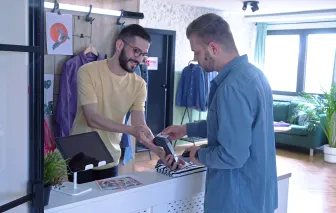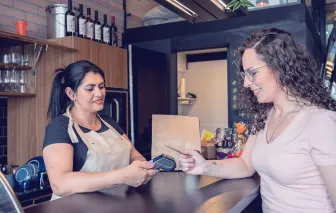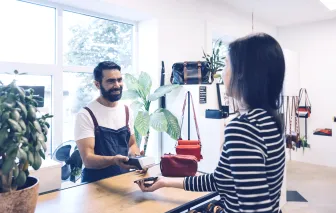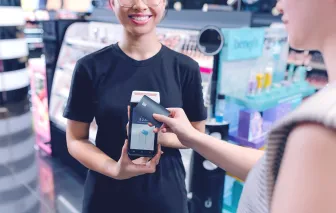Research shows most Canadians intend to use self-checkout when making grocery purchases and they’re open to using new technology like Amazon Go’s “Just Walk Out” system. With consumer preferences trending toward self-service, operators in all consumer-facing sectors, from transit and parking to quick service restaurants and convenience stores, should evaluate the edge unattended payment options can give their businesses. Merchants must also consider how to engineer self-service so that it delivers intuitive user experiences and minimizes shrinkage and loss. Read more in our blog.
Convenience-seeking consumers are increasingly turning to self-checkout. Research by Dalhousie University found that 2021 was the tipping point, with more Canadians preferring self-checkouts in grocery stores over checking out with the assistance of a cashier. Recent research from the university shows that 75% of Canadians intend to use self-checkout at grocery stores, and 85.1% are satisfied with those experiences. In addition, 47% are willing to shop in stores that offer an experience similar to Amazon Go, where shoppers put items in their baskets and then leave the store with digital sensors tracking their purchases with no checkout process required.
With consumer behaviors trending toward self-service and autonomy in their shopping journeys, it’s time for merchants to rethink processes to offer options that meet those demands in different payment scenarios, including:
- Retail
Although unattended payments have become common in grocery stores, other types of retailers can also benefit by offering the option. From convenience and big box stores to specialty retail, self-checkouts allow customers to skip the line and quickly complete purchases.
- QSRs
Self-service solutions in quick service restaurants (QSRs) allow guests to place and pay for their orders independently, saving time and increasing order accuracy. Self-service in QSRs also gives restaurants the potential to increase revenues by 10% or more.
- Micro Markets
Whether in a hotel lobby, a company break room, or a university space, micro markets allow consumers to choose snacks, healthy foods, beverages, or other items and pay for them on a smart vending machine or kiosk.
- Public Transportation
A popular unattended payment application is transit. Instead of waiting to purchase a paper ticket or token, unattended payment devices allow commuters to pay with debit cards or contactless payments. The result is shorter lines, greater operational efficiency for the transit authority, and ease of use for occasional riders and tourists.
- EV Charging
With more electric vehicles (EVs) on the road, more drivers will look for convenient ways to pay at EV charging stations. Deploying reliable unattended payment solutions with EV charging assures drivers that they can use their preferred payment methods and quickly get back on the road.
- Parking
Drivers will also appreciate the convenience of unattended payments in parking lots and garages. Systems allow drivers to insert their credit cards when they enter the facility and again when they exit to pay. These payment solutions move drivers through entrances and exits more quickly than ticket-based processes, helping to prevent traffic congestion. They also allow labor to focus on other tasks, keeping operating costs under control.
Improving Unattended Payment Experiences
Although the demand for self-checkout is high, merchants must implement them strategically to see the benefits. Systems should be easy for all consumers to use, regardless of their comfort with technology. Complaints about self-checkout tend to center on the experience they offer, not the concept itself. Merchants should ensure that it’s easy for the system to recognize products, scan efficiently, and weigh products, when necessary.
Part of a self-checkout strategy should also be protecting the merchant’s business from shrinkage and losses. A study from the ECR Community Shrinkage and On-shelf Availability Group (OSA) and NCR found retailers can see a 1 basis point stock loss for every 1% of sales through a self-checkout. That loss isn’t a foregone conclusion, however. Leading self-checkout solutions include features that prevent errors or intentional fraud.
Another way to enhance unattended payment experiences is to have employees nearby to assist customers. Self-checkouts allow customers to complete transactions independently, but issues can arise that require intervention from store employees. A combination of the right unattended payment technology, self-checkout system, and trained staff will provide experiences that build customer loyalty and maximize revenues and profits for the business.
Leverage Unattended Payments Expertise
Businesses new to offering self-checkout will find that accepting unattended payments differs from traditional card-present payments. Payment technology must be durable, secure, and vandalism-proof. It must also comply with Payment Card Industry (PCI) standards for unattended payment devices. The best solutions also seamlessly integrate with the merchant’s point of sale (POS) or management system and are backed by payment services from the technology provider.
Unattended payments will help merchants meet the demand for self-checkout and self-service in a range of applications, if merchants choose the right payment technology provider. Ingenico offers unattended payment devices, payment services, and expertise to help merchants deliver the greatest value to their businesses and optimize customer experiences. Contact us to learn more about making Ingenico unattended payment devices a part of your self-checkout solution.











